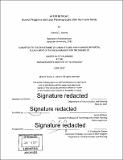| dc.contributor.advisor | Sarah Williams. | en_US |
| dc.contributor.author | Harvey, Amelia. | en_US |
| dc.contributor.other | Massachusetts Institute of Technology. Department of Urban Studies and Planning. | en_US |
| dc.coverage.spatial | n-us-ny | en_US |
| dc.date.accessioned | 2017-09-15T15:31:45Z | |
| dc.date.available | 2017-09-15T15:31:45Z | |
| dc.date.copyright | 2017 | en_US |
| dc.date.issued | 2017 | en_US |
| dc.identifier.uri | http://hdl.handle.net/1721.1/111383 | |
| dc.description | Thesis: M.C.P., Massachusetts Institute of Technology, Department of Urban Studies and Planning, 2017. | en_US |
| dc.description | Cataloged from PDF version of thesis. | en_US |
| dc.description | Includes bibliographical references (pages 75-82). | en_US |
| dc.description.abstract | State run home buyout programs are becoming increasingly popular as a means to mitigate flood damage to homes within floodplains. However, there are many local benefits associated with buyout programs, including the removal of services from the neighborhood, increased flood protection for adjacent neighborhoods, and increased green space for conservation and recreation purposes. With limited federal funding for these programs, policy designers make an effort to maximize these benefits. This thesis uses structured interviews, descriptive statistics, and mapping, to compare New Jersey's Blue Acres buyout program and the New York Rising Buyout and Acquisition Program. First, it compares the programs through the lens of 8 key policy decisions including parent institution, funding sources, municipal relationship, site selection, outreach, the offer, continued land management and future plans. Then, it uses a common framework to compare 3 coastal municipalities that utilized buyout programs, including Woodbridge, NJ, Lindenhurst, NY, and Mastic Beach, NY. I found that the ability to achieve local planning goals was influenced primary by the program's community outreach approach, site selection process, and its relationship with the municipality. As states design the next generation of buyout programs to deal with the increased flood risks associated with climate change, this paper will help guide buyout policy to achieve better outcomes. | en_US |
| dc.description.statementofresponsibility | by Amelia Harvey. | en_US |
| dc.format.extent | 82 pages | en_US |
| dc.language.iso | eng | en_US |
| dc.publisher | Massachusetts Institute of Technology | en_US |
| dc.rights | MIT theses are protected by copyright. They may be viewed, downloaded, or printed from this source but further reproduction or distribution in any format is prohibited without written permission. | en_US |
| dc.rights.uri | http://dspace.mit.edu/handle/1721.1/7582 | en_US |
| dc.subject | Urban Studies and Planning. | en_US |
| dc.title | After retreat : buyout programs and local planning goals after Hurricane Sandy | en_US |
| dc.type | Thesis | en_US |
| dc.description.degree | M.C.P. | en_US |
| dc.contributor.department | Massachusetts Institute of Technology. Department of Urban Studies and Planning | en_US |
| dc.identifier.oclc | 1003291693 | en_US |
